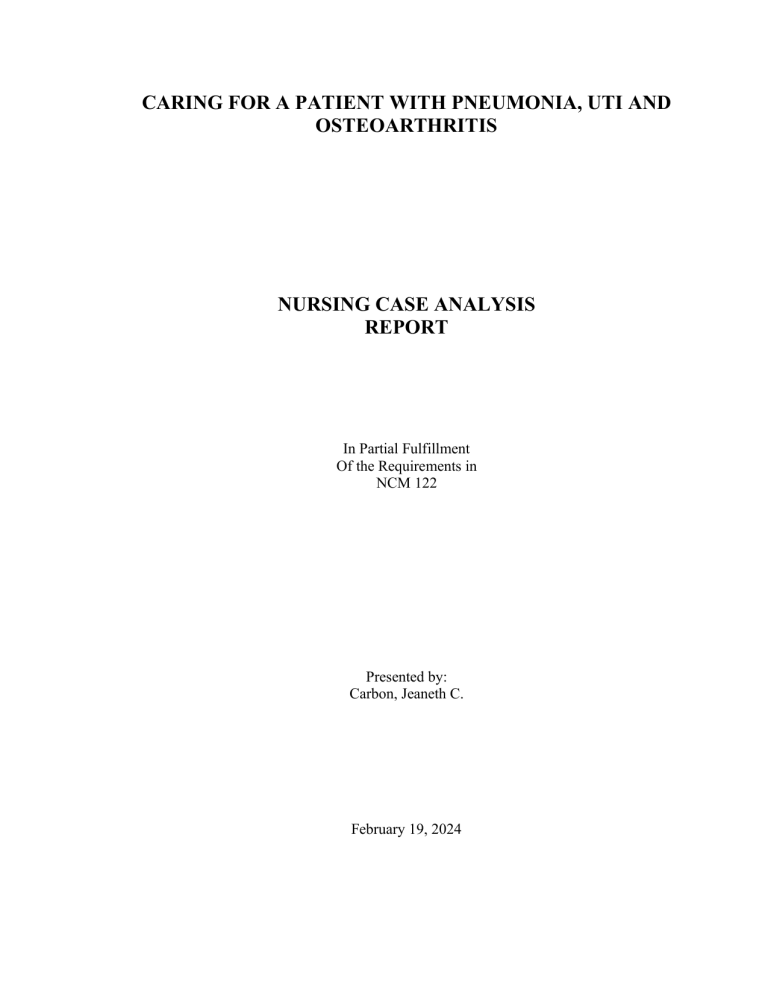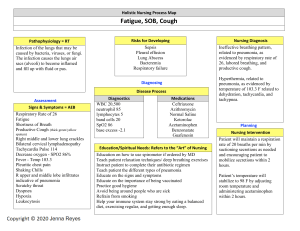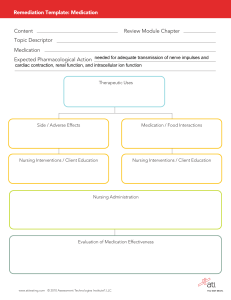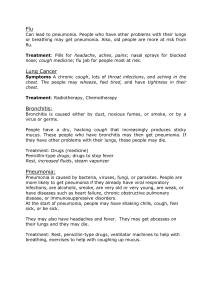
CARING FOR A PATIENT WITH PNEUMONIA, UTI AND OSTEOARTHRITIS NURSING CASE ANALYSIS REPORT In Partial Fulfillment Of the Requirements in NCM 122 Presented by: Carbon, Jeaneth C. February 19, 2024 Nursing Case Analysis Study I. Health History The subject of my study is M. V. D. is an 82 years old female who was admitted to Little Hospital Ph on February 9, 2024. Prior to admitting the patient to the hospital, M. V. D. had been in bed fast state due to Osteoarthritis. Mrs. V. was diagnosed as having Community Acquired Pneumonia with moderate risk complicated Urinary Tract Infection. and came in to Little Hospital for check up however she seek consultation for her present persistent fever. It was managed as UTI and she received medication of ciprofloxacin but after 5 days her fever persist. Her antibiotic was shifted to levofloxacin but after 5 days her fever persist hence they decided to get admitted. Infectious pneumonia may be due to a variety of microorganisms and can be community-acquired or hospital-acquired (nosocomial). A patient can inhale bacteria, viruses, parasites, or irritating agents, or a patient can aspirate liquids or foods. He or she can also develop increased mucous production and thickening alveolar fluid as a result of impaired gas exchange. All of these can lead to inflammation of the lower airways. Organisms commonly associated with infection include Staphylococcus aureus, Streptococcus pneumoniae, Haemophilus influenza, Mycoplasma pneumoniae, Legionella pneumonia, Chlamydia pneumoniae (parasite), and Pseudomonas aeruginosa. She was widowed last year of 2022 and was left to her daughter with her son in law and two grandson. She has 8 siblings, all of them has hypertension and Diabetes Milletus but only her was the exemption. Her daughter is her primary care provider and his other sons and daughters are sending her money for her allowance. She has been experiencing insomnia for 3 days and takes Benadryl to aid her into sleep. Soon after three days she experienced persistent fever and now with accompany of chills. On February 9th, doctor order piperacillin tazobactam for her complicated UTI that causes her fever and chills and after 2 days of admission and medications her symptoms did not persist anymore. Patient is also taking trimetazidine and atorvastation for atherosclerotic aorta but they only provide a medication during their first and second day and after that they did not comply anymore to the drug regimen. On February 12th, she was seen with occasional unproductive cough and the doctor order N-acetyleceistine and was relieved after a day. The patient was not compliant to the medication regimen since they was admitted. They only provide the mucolytic medication, vitamins and no more medication until discharge. II. Diagnostic Measures When M. V. D. was in the emergency unit the doctor order her for urinalysis, complete blood count and chest x-ray to confirm her diagnosis. Based on the urinalysis results showing moderate bacteria, elevated pus cells, protein, blood, leukocytes, and nitrite. The presence of bacteria along with these other elevated parameters indicates an infection in the urinary system.and others are also elevated such as pus cells, protein, blood, leukocytes and nitrite. Her CBC shows that her Hemoglobin decreases, polys increases this means that her blood count (CBC) results, a decrease in hemoglobin could suggest anemia, which can sometimes accompany infections or other underlying health issues. An increase in polys (polymorphonuclear leukocytes) typically indicates an increase in neutrophils, which are a type of white blood cell involved in fighting infections. The chest x-ray shows that her both lower lung has hazy opacities which suggest the presence of abnormal densities or areas of increased opacity in the lower opacity in the lower regions of both lungs. Hazy opacities can be used by various conditions including infections such as pneumonia due to accumulation of fluid or pus in the air sacs of the lungs. The diagnostic test helped the doctors diagnosed her that she has Community acquired pneumonia and with moderate complicated urinary tract infection. Community acquired pneumonia (CAP) refers to an acute pulmonary parenchyma acquired outside of the hospital. Moderate complicated UTI was a type of UTI that was also an infection that includes more than one organ in the urinary system (Sachev, 2023). III. Diet When M.V.D. was admitted her diet was low in salt and low in fat. She is allowed to eat only those with low salt and fat such vegetable dishes and other cafeteria dishes. She has atherosclerosis aorta that causes her chest pain sometimes and that is why the doctor order for her diet is the low fat and low sodium diet. The patient was instructed to eat vegetables more often and to limit or if necessary to avoid meat and chicken to avoid too much fat intake to control other underlying complications that will eventually help the other symptoms to subside. IV. Drug Therapy Their are almost fifteen drugs for the patient but the patient is not compliant to the treatment regimen. The SO of the patient only allow her to take the mucolytic drug and antibiotic for two days. The other drug for her osteoarthritis and other vitamins was not available in the patient’s stock since the Significant others are not complying to the medications regimen they only make an argument to the nurses who are reminding them. Her first day, she taken piperacillin+tazobactam 4.5g the only antibiotic the patient was taking used for any infections which is indicated to treat her moderate complicated UTI. She has also a PRN medication for her fever and chills which was Paracetamol 500mg. She was also taking Restor F a multivitamins and minerals for supplementation for vigor and stamina since the patient is too weak to move due to her conditions. She has also a Calcium+Vitamin D which was to help her bone to become more stronger as possible. Since her Hemoglobin was low the doctor ordered her to take ferrous sulfate to increase her hemoglobin level.Any medication such as trimetazidine, atorvastatine, azithromycin, n-acetylcysteine, diphenhydramine, prednisone, febuxostat, pantoprazole and glucosamin was not given. The significant others were adviced to comply to e medication regimen they only argue that they gave their medication in the nurse’s station but truly they did not submit any other medication. On February 13, the patient had a arthrocentesis at her right knee with intraarticular steriod injection was the last procedure she had and no other procedure followed. V. Other Therapy The patient has no other therapy ordered but the Significant others were advised to help their mother to have a passive range of motion exercises at least divided 30 minutes in a day depending on the tolerance of their patient since their mother was not able to move her right leg due to chronic pain in her knee due to osteoarthritis. Turning the patient side-to-side was also emphasize and given importance to make sure the patient will not develop any friction shear or lesion. Other like clean linens, clothing, and regular proper hygiene was emphasized to avoid any other infection or any caused of other infection. VI. Nursing Care Plan During first day of care the patient has occasional non-productive cough, she got her nebulization during the night shift and was not able to give any medication during morning shift since they do not have any supply anymore. The list of Nursing care plan was listed below in narrative form. The patient’s SO stated that she has been coughing but there is no phlegm expectorated. Patient status has an oxygen saturation level of 98%, without Oxygen, use of accessory muscle, and sleeping in Moderate high back rest. The formulated nursing diagnosis was Ineffective airway clearance related to secretions in the bronchi as evidence by observed sputum production in the chest x-ray results stating hazy opacities in the upper part of the lungs and Ineffective breathing pattern related to cough due to pneumonia as evidence by use of accessory muscle while breathing. This plan of care was intended for the patient to demonstrate appropriate airway clearance at least at the end of the shift and to demonstrate patent airway at the end of the week’s duty. Patient was monitored for respiratory changes, and her ability and effectiveness of cough to watch out for any exacerbation of her cough and difficulty of breathing. The care plan also encourage the patient to increase the fluid intake since their was no restriction to facilitate hydration and lubricate the phlegm. Positioning the patient was also significant also help the patient to have a adequate ventilation. At the end of the shift the patient display no exacerbation of cough and patient demonstrated a patent airway and good expectoration. Due to patient’s osteoarthritis, she has been experiencing pain during the first and second day shift and the next care plan has helped her manage her osteoarthritis. The patient’s folks verbalized that patient stays only in one position because it is very painful in the affected part. Patient’s right knee was swollen and warm to touch and every time her right knee was move in a very slight movement she will complain of pain. Chronic pain joint stiffness, degeneration and inflammatory processes evidenced by hesitancy to move joint. The patient was assessed with her pain scale and the factors that exacerbate the pain. Application of warm compress during morning was suggested to the SO and if pain persist they are also instructed to put a cold compress on the affected area at least every 30 minutes each day to minimize the swelling and pain. Patient was encourage to do ADLs with assistance and in schedule manner or breaks in between. Reminded about her maintenance and to reduce the pain and degeneration of the soft tissues. The patient’s BP has increased to 140/80 and it is in hypertension stage 1. Her next nursing care plan with diagnosis of Knowledge deficit related to ineffective health management of increased blood pressure. This care plan helped the client to lower her BP and how to maintain in the tolerable level. The patient was encouraged to eat more fruits and vegetables to help the BP maintain its current level. Introduced to relaxation techniques because when her right knee was in intolerable pain it can make her calm thus maintaining her blood pressure. Also, advised to comply with her medication regimen. The patient was not able to do her activities of daily living due to her chronic pain her right leg and right hand. The nursing diagnosis was Altered activities of daily living related to acute pain as evidenced by limited range of motion. The patient was encourage to ask for assistance for any movement she wish to allow her move to her extent tolerable pace. The family and caregivers were involved through giving them instruction on how will they help the patient to accomplish her task, incorporating the family will promotes commitment and understanding of each person’s value. They are instructed to rest between movement to regain energy and to continue. Caregivers and family are instructed to anticipate the need of the patient because the patient are shy to ask for help and she just lie on the bed. In addition, the patient developed pneumonia due to the fact that she cannot able to go outside the house and their house has different bacterias that she might be able to intake that causes her to have a pneumonia. She has been with pneumonia in her past history. Exacerbation and frequent occurrence of pneumonia was due to the patient’s inability to breath fresh air. If only she can have a better air and good ventilation, she might not have a frequent occurrence of pneumonia. The SO stated that, since the time she was diagnosed with osteoarthritis, she has been in bed lying almost all the time and she was easy to get sick. She also develop urinary tract infection because of unsafe usage of diaper, as the patient verbalizes that she cannot urinate well in the diaper and she will just hold her urge until she cannot longer hold the urge then she can urinate. After being in bed for how many hours a day the patient might be able to have pressure ulcer. Another nursing care plan was about Risk for impaired skin integrity related to alteration of physical movement. The SO was instructed to turn the patient from side-to-side every 2 hours to avoid any warmness in the sacral area or any area which is warmed and heated for how many hours of lying down. Encouraged to use lotion for moisturizer and make sure temperature was in enough to cool down every areas in accordance to patients’ preference. Reminded to always change lines and other bedding when already dirty or soaked with fluids. VII. Teaching Plan The patient and the significant others were thought proper hygiene such proper hand washing that pneumonia can also be from anything that was taken by the mouth and bacteria goes down to the lungs. Hand washing technique was the every first and at home mitigation to avoid any high risk for any kind of diseases. The Significant others are also thought for proper ventilation most especially for the patient so the negative air in their room will exit from the window and fresh air will enter and adequate exposure to healthy sunlight may also give some vitamins for them and which is also best for the patient. Turning the patient from side-to-side was also emphasize since their patient was almost a bedridden due to her illness, friction ulcer was a high risk Appropriate cleaning of the house, eliminating dust and possible bacteria in any areas in the room of the patient such as spraying Lysol but making sure when spraying the patient is wearing mask or transported to the other room. Encouraged to eat more vegetables and fruits, less fats and salts will also make the patient’s BP and/or maintained. Proper hygiene, most especially genital care since the patient has a UTI, infection due to hygiene related bacteria can also be a cause of UTI. Encouraged the SO to change the diaper of the patient every time it is already wet because it might cause discomfort, rashes and itchiness to the patient.





